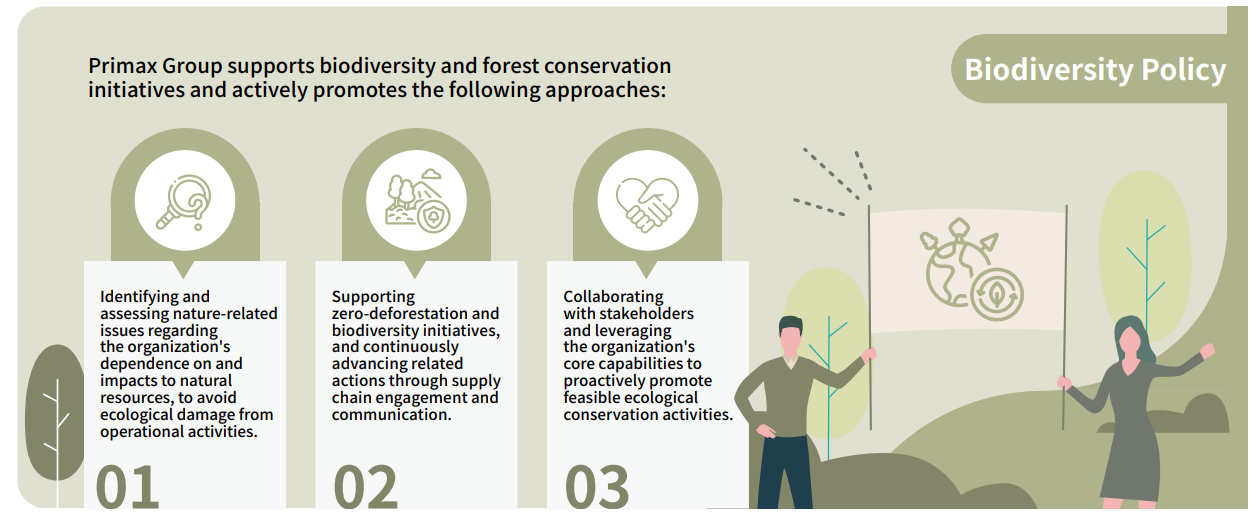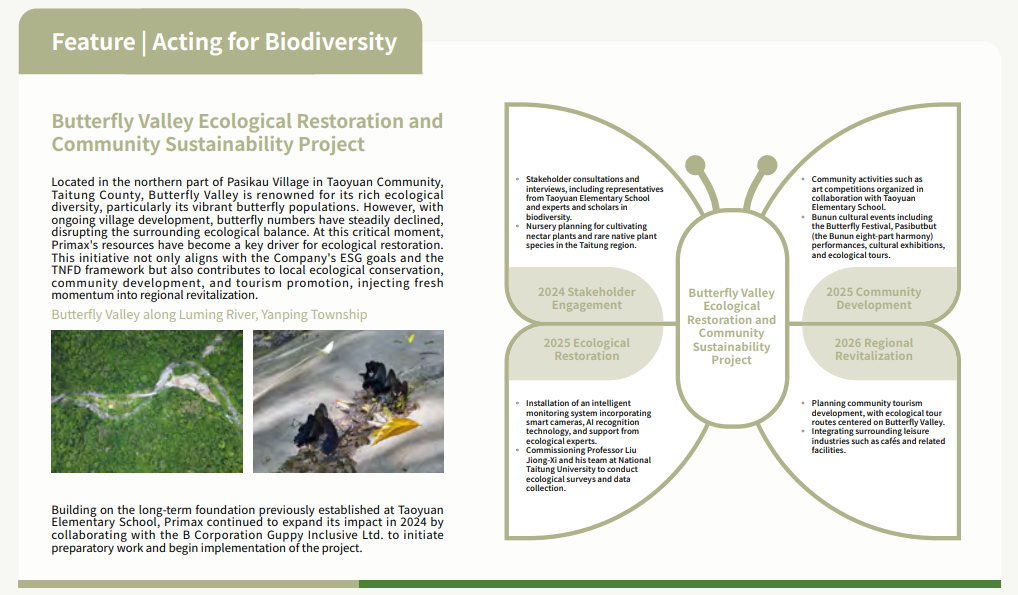Commitment and Actions
As global sustainability trends accelerate, climate change, natural resource depletion, and biodiversity loss have increasingly become critical risks to long-term business continuity. Although Primax operates within the information and communications technology (ICT) industry and is not engaged in highly polluting manufacturing processes, we recognize that our operations and upstream and downstream supply chains may still exert indirect impacts on the natural environment and ecosystems. To address these challenges, Primax actively adopts the Taskforce on Nature-related Financial Disclosures (TNFD) framework, working closely with suppliers and partners to align with the United Nations Sustainable Development Goals (SDGs), the Convention on Biological Diversity (CBD), and the Kunming-Montreal Global Biodiversity Framework (GBF). Through these efforts, we strive to advance a sustainable business model that balances economic benefits with ecological value, paving the way toward a more resilient and responsible industry.
Guided by the LEAP approach (Locate, Evaluate, Assess, Prepare), Primax promotes avoidance, mitigation, restoration, offsetting, and additional conservation actions. Our ultimate goal is to achieve No Net Loss (NNL) by 2050 and move toward Net Positive Impact (NPI), in line with global targets for natural capital protection.
We integrate natural capital risk assessments into enterprise operations and climate risk management, thereby establishing a comprehensive sustainability risk management framework. Through this approach, we reinforce responsible management of natural resources and demonstrate our long-term sustainability commitment.
Key Actions for Biodiversity Management
1. Policy Commitment
− Establish a “Biodiversity and No Deforestation Policy,” formally integrated into the company’s governance structure, with regular review and updates.
2. Operational Controls
− Implement low-energy, low-waste assembly processes; avoid the use of hazardous chemicals; and continuously enhance water-use efficiency.
3. Supply Chain Management
− Require suppliers to comply with international environmental standards (e.g., environmental management systems, forest certifications), and adopt sustainable procurement practices.
4. Ecological Project Support
− Invest in habitat conservation and community-based ecological education initiatives, supporting local ecosystem restoration and long-term biodiversity monitoring.
5. Performance Disclosure
− Evaluate biodiversity-related management performance based on TNFD indicators, disclosing concrete outcomes and improvement directions in the annual sustainability report.
Primax’ s Biodiversity and Deforestation-Free Policy

Adoption of the LEAP Methodology
In response to the increasing global focus on nature-related risks and opportunities, Primax has formally adopted the Taskforce on Nature-related Financial Disclosures (TNFD) framework and conducted a comprehensive assessment in alignment with its core LEAP methodology. Through this structured four-stage process, Primax systematically identifies, evaluates, and manages its interactions with the natural environment, establishing a solid foundation for formulating future sustainability strategies and strengthening overall operational resilience.
LEAP Implementation Status at Each Phase
Step 1: Locate

Locate Analysis Results:
- Primax Group Affiliated Companies:
—10 major production and operational sites are not directly located within ecologically sensitive hotspots.
—Three affiliated companies were identified as having sites potentially located within ecologically sensitive areas. Upon verification, it was confirmed that the operations of these entities are limited to non-production activities, such as office functions and logistics management, without any manufacturing processes. A preliminary assessment indicates that the dependency and potential impacts of these sites on water bodies, soil, and ecosystems are minimal, with no material negative impacts observed.

- Primax Group Significant Suppliers :
—All 45 Significant Suppliers are not directly located within ecologically sensitive hotspots.
Step 2:Evaluate

Evaluate Analysis Results:
- High-risk categories of nature-related dependencies, impacts, and physical risks have been identified (based on the results of BRF and WRF analyses), as summarized in the table below:
—Analysis results of nature-related dependencies, impacts, and physical risk categories for the ten major production and operational sites of the Primax Group:

—Analysis results of nature-related dependencies, impacts, and physical risk categories for Primax Group’s Significant suppliers:

- High-risk nature-related dependency and impact factors have been identified (based on the results of BRF and WRF analyses), as summarized in the table below:
—Analysis results of nature-related dependency and impact factors for the ten major production and operational sites of the Primax Group:

—Analysis results of nature-related dependency and impact factors for Primax Group’s Significant Suppliers :

In the ENCORE analysis, Primax selected the industry category of Manufacture of Computers and Peripheral Equipment. The analysis identified only one high-risk item with a High Materiality Rating: Emissions of toxic pollutants to water and soil.
Among Primax Group sites, except for Primax Dongguan, all other facilities are assembly plants and do not generate industrial wastewater. The industrial wastewater discharged from Primax Dongguan fully complies with the local Guangdong Province Discharge Limits of Water Pollutants standards. Other sites only use water for domestic and public purposes, and all wastewater is discharged into local sewer systems or industrial management areas in accordance with regulations, posing no significant impact on local water bodies. All hazardous waste generated by the Group is managed by licensed treatment service providers, and no major waste leakage incidents have occurred. Waste management practices at all sites comply with applicable national laws and regulations. Primax will continue to implement diversified and concrete environmental measures to minimize adverse impacts on the natural environment, demonstrating its commitment to sustainability.
Step 3:Assess

Step 4: Prepare

Advancing Cross-disciplinary Restoration Initiatives : Primax – Butterfly Valley Restoration Project (Phase 1: 2024–2026)

Wildfire Hazards Primax : Thailand,Tymphany : Thailand
Tropical Cyclones Primax : Taipei /Kunshan / Dongguan ,Tymphany: Taipei /Huizhou/ Dongguan
Flooding (WRF) Primax : Kunshan / Dongguan / Chongqing ,Tymphany: Huizhou/ Dongguan
Drought (WRF) Primax : Taipei / Dongguan / Thailand
Tymphany: Taipei /Huizhou/ Dongguan / Thailand / Czech Republic



